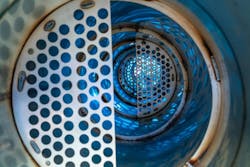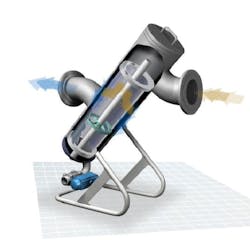Fluid filtration in industrial heat exchangers: Challenges and solutions
Heat exchangers play a pivotal role in numerous industrial processes. These devices facilitate the efficient transfer of heat between fluids, which is essential for either heating or cooling operations. As fluids pass through the exchanger, heat is transferred from the warmer to the cooler fluid via heat exchange elements designed to maximize surface area and facilitate heat flow. The cooler fluid then removes heat, useful for either raising temperatures in heating applications or eliminating waste heat in cooling ones. Heat transfer systems may be closed-loop, isolating fluids from the environment, or open-loop, exposing them, which affects filtration strategies.
While the following insights are broadly applicable to industrial organizations that rely on effective filtration strategies, it is important to recognize that they cannot encompass every scenario encountered in diverse environments. This limitation underscores the importance of initiating an audit of filtration system needs, conducted by a knowledgeable expert, that can lead to tailored solutions addressing the distinct demands of their operations.
About transfer mediums
Exploring the basics of heat transfer fluids (HTFs) lays the foundation for grasping heat exchanger fluid filtration strategies. Water stands as one of the prevalent transfer mediums, acknowledged for its exceptional capacity to carry heat. Blends of ethylene or propylene glycol and water also find extensive use as HTFs, alongside thermal oils known for their elevated boiling points and robust stability. Additionally, fluids such as silicone oils, molten salts and liquid metals such as sodium or potassium are employed in specific industrial processes or power generation applications.
In cooling systems, common refrigerants include chilled water, ammonia, ethylene and brine solutions, the latter being ideal for various applications requiring cooling below the freezing point of water. Other specialized fluids, prevalent in the chemical and pharmaceutical sectors, are also utilized according to unique process requirements.
Irrespective of industry or application, obstacles emerge when impurities hinder heat exchange equipment from achieving the necessary thermal transfer efficiencies. For closed-loop circuits, these particulates may accumulate as fouling introduced when replenishing heat transfer fluids, products of wear from pumps, flow control equipment and pipe erosion, pipe scale accumulation and biomatter formation.
In open-loop systems, all the above plus additional environmentally introduced contamination such as airborne particulate matter from cooling tower operation or algae and silt from raw water intake, for instance, can contaminate the working media, resulting in the obstruction or blockage of the heat exchanger or loss of effective heat transfer surface area. Moreover, foreign particles might induce harm to other process equipment components in the system, including instrumentation, control valves and pumps.
In these cases, effective filtration becomes the cornerstone for ensuring operational efficiency, product quality and environmental sustainability across diverse industrial landscapes.
Challenges in heat exchanger fluid filtration
One crucial factor affecting heat transfer media filtration is the intrinsic value of the fluids. Protecting the quality of high-value HTFs is especially critical, resulting in significant cost reductions by lessening the need for costly fluid replacements and maintenance interruptions. Additionally, promoting the sustainable use of fluids is essential for minimizing environmental impact, in accordance with the trend toward conscientious resource management. Meanwhile, raw water and certain "improved" HTFs, which undergo chemical treatment and filtration, may not be classified as high value. Nevertheless, they equally require efficient filtration to ensure their integrity.
Industrial operators often encounter fluid filtration hurdles linked to cooling tower systems, which are open-loop cooling circuits that use evaporation of water as the means to dispose of waste heat to the environment. As a significant amount of the water evaporates and is lost, replenishment becomes a key factor. Sources of replenishment water may include rivers, lakes, retention basins, wells or even municipal water supply.
Given the variable quality and cleanliness of water from these varied sources, open-loop liquid straining and filtration solutions need to be flexible to address diverse impurities entering the system, addressing issues such as debris accumulation and the growth of organic elements like algae or bacteria. Additionally, operation of the open-loop circuit can introduce additional contamination as water is exposed to the atmosphere through nozzles. These airborne and windborne contaminants will accumulate in the circuit, eventually causing issues with pumps, nozzles and the internal heat exchangers. Seasonal variations and geographical location can introduce further types of contaminants that require consideration.
Amid these challenges, a multi-tiered solids separation strategy can provide dependable results at all stages of the replenishment and operation cycle. The tiers include pipeline strainers at the intake stage to remove coarse debris, self-cleaning filtration to remove fine particulates and the use of replaceable filter media such as bags or cartridges at the finest retentions for closed loop protection. These separation and filtration systems, as well as chemical treatment to prevent biomatter and pipe scale accumulation, ensure a minimal risk of fouling of heat transfer equipment as well as extending the life and reliability of all thermal loop process equipment.
The self-cleaning advantage
In scenarios demanding uninterrupted operations and seamless filtration processes, there exists multiple self-cleaning filter technologies. The selection of the optimum self-cleaning filter system for an application depends on the filtration level required, process parameters (flowrate, pressure, temperature, fluid chemistry) and fluid value. They can easily integrate into all common plant automation and control systems. Every self-cleaning filter generates a waste stream from their regeneration operations, and their cost of ownership depends on utilities consumption, preventative maintenance schedule and the handling expenses of the discharge waste stream.
Enhancing production efficiency at the highest throughput
The significance of efficient filtration for heat exchanger fluids becomes evident when assessing the favorable outcomes of a “better” solution specifically within iron and steel plants. Here, excessive water usage can trigger various contamination issues, while water is required to cool the heat generated by furnaces and associated machinery, crucial in maintaining optimal system performance. The highest capacity coarse liquid-solid separators for high volume applications are automatic self-cleaning strainers.
Consider the scenario of a leading manufacturer who consistently produces over 13 million tons of high-grade iron and steel each year. Within the iron-making furnace equipment, water utilized for cooling is collected and directed upstream to a collection sink basin. Subsequently, it is pumped onward at a flow rate of 13,210 gallons per minute (3,000 m³/h) to a heat exchange recycle system. However, the collected water may contain high levels of contamination, including iron fragments, sand and mineral particles.
This can create significant issues within the heat exchanger as contaminants larger than 4 mm in size have the potential to damage delicate components like flow rate valves, impacting their efficiency. Thus, the situation necessitated biweekly cleaning sessions, triggering frequent shutdowns and incurring considerable production losses for the plant.
Recognizing the inadequacy of the existing filtration system, the manufacturer turned to Eaton to tackle these issues. After comprehensive technical discussions, a Model 2596 automatic self-cleaning strainer with a 3.9-mm (5/32") convoluted perforated element was identified as the ideal solution for the water intake system.
This motorized strainer, designed for the continuous removal of solids from liquids in pipeline systems, effectively eliminates particles larger than 4 mm, mitigating the risk of damage to downstream components. Its automatic self-cleaning feature also provides uninterrupted flow. Implementing this new system significantly reduced unplanned disruptions to the local heating system and decreased water consumption in the plant by approximately 20%. Furthermore, maintenance shutdowns were minimized to once a year.
Minimizing waste of high value HTF’s
For intermediate filtration retention application with higher value fluids, the preference invariably leans toward mechanically cleaned filters. These systems excel in environments where halting activity or filter media change-outs is not feasible. Utilizing innovative methods and mechanisms, these filters effectively eliminate impurities while maintaining ongoing operation. They also produce a minimal waste stream.
The efficacy of mechanically cleaned filters is especially pronounced when dealing with heat transfer fluids of medium value level. In this context, "medium value level" refers to the fluid's properties, such as viscosity, particulate load and chemical composition, which fall within a midrange spectrum. These filters excel in such conditions because they can effectively handle the balance between thorough filtration and maintaining the integrity and flow rate of the heat transfer fluid. Their precise engineering allows them to capture and remove contaminants efficiently without significantly impeding the fluid's movement or heat transfer capabilities, thus ensuring optimal performance of the system.
Mechanically cleaned systems are also notable in reducing waste. They excel at keeping clean and functional while reducing purge water quantities, necessitating less disposal. This efficiency can support environmental conservation by diminishing waste output and can lead to cost savings by cutting down on expenses related to waste handling and disposal. Usually, through efficient concentration and extraction of debris, these filters can produce only a fraction — approximately one-tenth — of the waste discharge observed in standard filtration setups.
Reliability and scalability for fine filtration
Automatic tubular backwash filtration technology offers substantial value for customers who need reliability and scalability. This type of filtration system incorporates tubular elements specifically designed to capture contaminants efficiently. The number of tubes in the system dictates the filtration capacity, and the system offers a degree of redundancy in that a single tube can be taken offline for service while the remaining system continues to operate. The distinct feature of tubular backwashing technology lies in its cleaning mechanism, where reverse flow is applied to only a single filter element at any one time. This selective backwashing significantly cuts down on the volume of fluid needed for cleaning — in contrast to systems that clean the entire filter surface simultaneously — which conserves water while maintaining high levels of filtration effectiveness.
Tubular options, as well as self-cleaning pipeline strainers, which are used to separate larger particles, typically fall into the "better" category for minimizing backwash generation, with mechanically cleaned filters generally considered the "best" solution. Notable is that tubular backwashing solutions tend to offer the additional benefit of delivering the widest range of filter media options for retention, material of construction and surface area of all of the aforementioned self-cleaning filter technologies. The finest grades of self-cleaning filter media are available only on tubular backwashing systems.
Closed-loop filtration
While closed-loop systems excel at preserving fluid cleanliness by averting exposure to contaminants, filtration remains essential. Despite the reduced risk factors compared to open-loop systems, closed-loop systems can still face contamination issues arising from new construction activities and the accumulation of rust, scaling and other substances within the pipes.
Suspended particles, if not addressed, have the potential to traverse the system in the water and accumulate in undesired locations, such as cooling tower fans. This can impede operational efficiency and result in equipment fouling.
Therefore, the choice of filtration technique is crucial in influencing the efficiency, durability and overall effectiveness of the system. Within the context of closed-loop systems, bag and cartridge filters stand out as notably efficient options for several compelling reasons.
Efficiency and longevity
Bag filters, with their sizable surface areas, are adept at handling high flow rates and significant volumes of contaminants without a substantial drop in pressure. Cartridge filters, on the other hand, are known for their precision in capturing fine particulates, thanks to the dense media packed within a compact form factor. Both types are engineered to maximize contaminant capture over extended periods, thereby reducing the frequency of filter replacements. This not only ensures consistent filtration quality but also minimizes system downtime associated with maintenance.
Versatility and range
Manufacturers have developed a vast array of filter options with varying pore sizes, materials and configurations, each designed to address specific contaminants, fluid types and filtration efficiency requirements. Whether the requirement is for a robust filter capable of handling large debris in industrial applications or a fine-mesh design for the delicate removal of minute contaminants in sensitive processes, the market offers solutions tailored to every conceivable scenario. This diversity ensures that there is a filtration solution available for virtually any closed-loop system, regardless of the complexity or specificity of the need.
Each type of filter can thrive in its respective domain when utilized correctly, highlighting the necessity of accurately assessing filtration needs. For instance, bag filtration systems shine in small-scale processes where cost efficiency is as vital as filtration effectiveness. Their generous surface area is well suited for these operations, preventing rapid blockage and minimizing the frequency of bag replacements. Conversely, cartridge filters excel in scenarios that require exceptionally pure water, facilitated by the availability of filters with very fine pore media and high surface area structures.
Ultimately, the wide range of options and flexibility offered by both bag and cartridge filters greatly simplifies the process of finding an appropriate solution for a variety of applications.
Solving the value equation
The liquid filtration solutions market caters to a broad array of needs, from achieving high filtration standards and protecting equipment to complying with strict regulatory guidelines. Particularly crucial for the operational efficiency of heat exchangers, effective fluid filtration is paramount. As such, the decision-making process around filtration methods becomes increasingly important, accounting for such factors as the value of the fluid, waste management strategies and sustainability initiatives.
Filtration solution providers, including specialists like Eaton, offer an extensive selection of methods that adopt a comprehensive approach to enhance process efficiency and optimize system performance. Understanding the unique requirements of each application and making well-informed decisions about filtration techniques are essential to address the dynamic demands of modern industries.
Additionally, ongoing advancements in filtration technology are paving the way for innovative solutions capable of tackling more complex challenges. Starting this journey with a consultation with a filtration expert is an effective strategy for accurately assessing and identifying the right solution.






